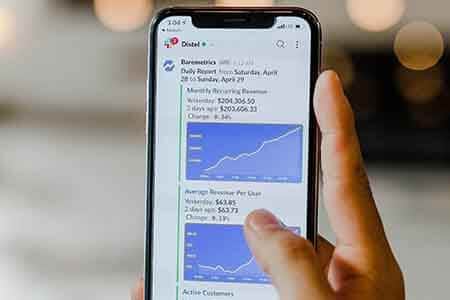How to Short Bitcoin in 3 Simple Steps
Bitcoin has been around for over a decade, but it only caught the world’s attention when its value skyrocketed to around $20,000 per BTC in late 2017. Some thought cryptocurrencies would take over fiat currencies, while others thought Bitcoin was just the latest bubble.
Yet, because of the peculiar nature of the cryptocurrency, short-selling in the traditional sense was historically not possible. Fundamental crypto-bears and speculators watched Bitcoin fall almost 75% in 2018 with few formal ways to bet against it.
Today, many online brokers offer different ways to short major cryptocurrencies. In this guide, we teach you how to short bitcoin and also review some of the best cryptocurrency brokers on whose platforms you can short bitcoin and other cryptos:
-
-
Our 3-step guide to shorting Bitcoin
Step 1: Choose a broker that allows you to short Bitcoin
1. CryptoRocket: Up & coming crypto-focused broker with higher leverage limits
CryptoRocket is a recent, crypto-focused broker with a wide range of classic pairs (e.g. BTC/USD) and pairs(e.g. ETC/BTC) available to trade via CFDs. In addition to Cryptos, it also offers Forex, popular Stocks, Indices & Commodities as well as Dollar Futures.
As a recent platform, CryptoRocket is focused on simplicity. Opening an account is very fast, with only one account type, and CryptoRocket allows you to trade on a free demo account to get familiar with the process. The minimum deposit is low ($10) and you can fund your account via credit card, wire transfer, or directly via a Bitcoin wallet.
The trading platform is integrated into the popular MetaTrader software, allowing you to trade from the web, desktop, or mobile with a leading platform. MetaTrader is not always intuitive at first, but it becomes very powerful once you learn to use the wide range of charting & analysis tools available.
CryptoRocket offers competitive spreads on all cryptocurrencies & pairs and leverage up to 1:100 for cryptocurrencies. As usual, particularly in the context of short-selling, remember that leverage is an option that comes with potentially higher profits but much higher risk and should be used with caution. Should you have any questions, CryptoRocket’s customer service is very responsive and runs 24/7!
While it has quickly gained in popularity & credibility, CryptoRocket remains an offshore broker based in St Vincent and Grenadines (presently not regulated in the US or the EU+UK).
Our Rating

- Wide range of cryptocurrencies & pairs via CFDs
- Fast signup process, easy deposits & withdrawals
- Competitive spreads & higher leverage options
- Overall range of tradable assets remains limited
- Offshore (unregulated) broker
Disclaimer: Transacting in ETFs, Stocks, CFDs and other financial instruments is subject to various risks, such as price volatility, and is not suitable for everyone. Your capital is at risk.Step 2: Learn how to short Bitcoin
 How does short-selling work?
How does short-selling work?Short-selling is the practice of borrowing an asset, selling it, and waiting for it to lose value before repurchasing it and giving it back to the lender. It is widely used in the stock market to profit from temporary or permanent declines in asset prices.
While some see them as pure speculators, short-sellers play a crucial role in the financial markets. When asset prices increase beyond their fundamental value, short-selling can exert downward pressure and bring prices back in line. Short-selling is a powerful tool to contain bubbles, punish poor or fraudulent managers, and protect capital in a bear market. For more on this, review our detailed guide on How to Short Stocks.
What can cause the price of Bitcoin to decline?
Like any other asset, the price of Bitcoin is a function of supply and demand.
At its core, the number of Bitcoins that can be mined is finite, and every day fewer Bitcoins are mined. If demand stays constant, as more Bitcoins come into existence, prices should naturally fall.
However, the relevant “supply” of Bitcoin is not the number of coins in existence but the number of coins people are selling in exchange for another currency (say, the US dollar). Similarly, the “demand” for Bitcoin is the number of people selling their dollars to buy Bitcoins.
To understand what can make the price of Bitcoin fall, you need to find what can lead to more supply or less demand. Let’s consider some examples:
- Regulatory fears. When China decided to crack the whip on mining, or when regulators around the world said they considered restrictions on cryptocurrencies, the price of Bitcoin reacted negatively. More generally, serious regulatory actions (bans, limits, crackdowns on exchanges) can hurt the price of Bitcoin.
- Large-scale fraud. Reports of major hacks and large-scale Bitcoin thefts can simultaneously scare off buyers and trigger panic selling, hitting the price of Bitcoin hard.
- Bitcoin exchange failures. The best Bitcoin exchanges are not sheltered from risks and are vulnerable to fraud, poor management, or insolvency. When major exchanges fail, such as Mt. Gox in 2014, it can trigger a decline in the price of Bitcoin and other cryptocurrencies.
- Hard forks. The creation of Bitcoin Cash in 2017 led to a slew of crypto-enthusiasts switching from BTC to BCH, with a temporary negative price impact on BTC. Hard forks (major changes in technology) can, therefore, negatively affect the price of Bitcoin.
- Movements in the first coins mined by Satoshi Nakamoto. Most Bitcoin enthusiasts will know about the million or so Bitcoins mined by the mysterious Satoshi Nakamoto. While the “father of Bitcoin” has remained dormant, his Bitcoin holdings are so large that he could severely hurt BTC’s price should he one day decide to sell in large chunks. This is obviously speculative, but neatly illustrates the dynamics of supply and demand.
- Panic & “dash for cash”. When markets are collapsing and investors are running for the hills, Bitcoin may not be immune to large-scale selloffs. The recent coronavirus crisis is a testament to Bitcoins’ vulnerability to contagion from the global financial markets.
What are the main ways to short Bitcoin?

Unlike other assets, Bitcoin prices can be extremely volatile, which offers traders as much opportunities on the upside as on the downside, short-selling BTC is risky but can be very profitable.
Traditional short-selling (borrowing, selling and repurchasing) is very difficult for Bitcoin. If you want to do it, you will need to resort to derivatives, such as CFDs, ETNs, Futures, and Options.
Shorting Bitcoin via CFDs
Contracts-For-Difference (CFDs) are derivative products that allow you to “bet” against the broker on the direction of an asset’s price. Neither the broker nor you effectively own the asset. You simply try to anticipate its price movement. For more on this, learn how to trade CFDs with our dedicated guide.
Trading Bitcoin via CFDs is simple, intuitive, and a lot of online brokers allow it. Unlike other derivatives, CFDs are easy to understand and are more accessible to retail traders. Since no assets change hands, you do not need a crypto wallet or to worry about hacks on many crypto exchanges.
When you enter a “Sell” (short) Bitcoin order via CFD, you effectively bet the cryptocurrency broker that the price of BTC will decrease. For you to make money, you need a large enough drop in prices to offset your costs.
As for the fee structure, the broker typically charges a bid-ask spread (the difference between the buying and selling price) and daily fees to roll-over your position. These daily fees (<10 bps) tend to be lower for short positions, primarily because of the tendency of asset prices to move up in the long run.
Let us take a simple example:
- Day 1 (BTC trades at $5,000): You decide to short 1 Bitcoin. The bid (price at which you “sell” to your broker) is $4,950. You pay a daily fee: $2.
- Day 2 (BTC trades at $5,100): Your trade is losing, but you decide to wait. You pay a daily fee: $2.
- Day 3 (BTC trades at $4,850): Your trade is winning, and you decide to close it. The ask (price at which you “buy” back from your broker) is $4,900.
You sold at $4,950 and bought back at $4,900. Your trade rolled over to the next day twice, so you paid $4 in fees. Your net profit is thus $46 (~1% of your position).
Shorting Bitcoin’s Exchange-Traded Notes
Exchange-Traded Notes (ETNs) are similar to Exchange-Traded Funds (ETFs) with a few key differences. ETFs are listed funds that hold stakes in companies and that sell shares of the fund to the public on an exchange (similar to stocks). By contrast, ETNs are structured products in the form of senior debt notes (similar to bonds). To learn more, consult our Best ETFs Brokers guide and our guide on Bond Investing.
Several ETNs on various exchanges allow you to indirectly trade on the price of BTC. For example, the Bitcoin XBTE ETN listed on the NASDAQ OMX Nordic may be accessible to buy or short via a traditional broker. Note, however, that ETNs can be complicated products. make sure you thoroughly understand them before taking this approach.
Trading Bitcoin Options & Futures
Lastly, another way to short Bitcoin is to trade options or futures, two types of derivative products available on select stock exchanges. In the U.S., the Chicago Mercantile Exchange and the Chicago Board Options Exchange offer a range of BTC futures and put options for BTC bears. Other platforms, such as Deribit, offer a variety of Bitcoin derivatives to trade. In Europe, it is harder to access these products.
Futures and Options are risky products and may not be suited to retail investors. To learn how to trade them, consult our Options Trading guide and our review of the Best Futures Brokers.
Step 3: Set up your account and start trading
Now that you chose a broker and understood how to short Bitcoin, let’s look at how you can place your first trade.
Set up an account with a broker of your choosing, and you can short BTC directly from the terminal.
The Bottom Line
In this guide, we explained how short-selling Bitcoin works and how to get started with the right broker.
Shorting Bitcoin is not easy and carries some risks, but it can be very profitable if done correctly. The key is not just to calculate the price drop you need to cover the fees and make a profit, but to get the timing right. Good luck and happy trading!
FAQs
What are the main ways to short Bitcoin?
The simplest, cheapest and most accessible way is to short via CFDs. If you have access to them, you may also try to short Bitcoin ETNs or use Options and Futures to take directional bets.
How volatile is Bitcoin?
Bitcoin is arguably one of the most volatile assets in the world. In the past, BTC has frequently jumped or fallen >30% in a single day!
How does a margin call work?
If you short Bitcoin and its price rises a lot, your broker may decide that you dont have enough money in your account to cover your possible losses. The broker will then require you to put more money in your account (the margin call). If you cannot, the broker will liquidate your position.
Do I need a crypto wallet to trade Bitcoin?
You can have one, but you do not need it to trade via CFDs! Bitcoin CFD trading does not involve ownership of Bitcoin, it is simply a directional bet on the price of the asset.
What type of fees can I face in short-selling Bitcoin?
Short-selling fees will typically include the bid-ask spread and daily rollover costs for multi-day positions.
See Our Full Range Of Cryptocurrency Resources – A-Z
Adam Green
Adam Green
Adam Green is an experienced writer and fintech enthusiast. He he worked with LearnBonds.com since 2019 and covers a range of areas including: personal finance, savings, bonds and taxes.View all posts by Adam GreenWARNING: The content on this site should not be considered investment advice. Investing is speculative. When investing your capital is at risk. This site is not intended for use in jurisdictions in which the trading or investments described are prohibited and should only be used by such persons and in such ways as are legally permitted. Your investment may not qualify for investor protection in your country or state of residence, so please conduct your own due diligence. Contracts for Difference (“CFDs”) are leveraged products and carry a significant risk of loss to your capital. Please ensure you fully understand the risks and seek independent advice. This website is free for you to use but we may receive commission from the companies we feature on this site.
Copyright © 2025 | Learnbonds.com
We use cookies to ensure that we give you the best experience on our website. If you continue to use this site we will assume that you are happy with it.Scroll Up
